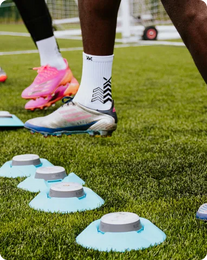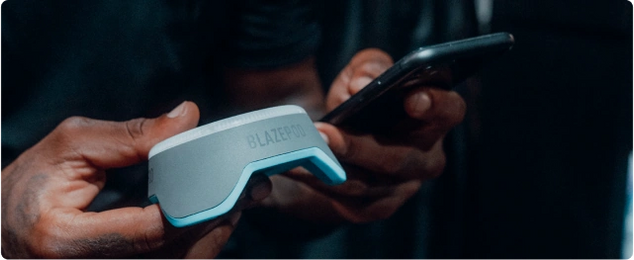The term Flash Reflex™ (FRX) training is one used often when speaking about BlazePod and the BlazePod Experience. You’ve probably noticed it in BlazePod updates, social media and, of course, Academy content, and thought to yourself, what exactly is FRX? How did this training system evolve and why is it crucial for training and therapy?
#HERO#
This blog post will answer any questions you may have about the FRX training system, and explain why it should be adopted into your, your athletes’ and patients’ regiments.
The Origins of FRX Training
FRX training was designed for all coaches across the sports and fitness industries, from sports coaches to trainers and physiotherapists, it helps athletes and clients progress and reach their goals. BlazePod created FRX as a philosophical twist to visual reaction training that is designed to help athletes become smarter, more agile and efficient in their sport.
What does that mean in practice?
The FRX system trains athletes to react instinctively to any situation they may find themselves in by triggering the body’s natural response to sensory stimulations and enabling superior, fast and coordinated movement. The body responds in an almost instinctive manner to the Pod’s lights, almost as if the flash of the Pod is triggering a reflex. When translated to game situations, this means athletes will react without having to mull over the current situation in their heads, wasting valuable game or match time. Just think of the best athletes in the world, like Ronaldo, LeBron James, sometimes when they’re playing it feels as if time has slowed, and they have all the time in the world to do as they will. But in reality, has time really slowed? We know that’s not really an option. So how is it that they are simply able to see everything on the field and court faster than others, process what it is they are seeing and deduce on how to respond before others have the ability to do so?
The answer lies in cognitive training and synchronizing cognitive and physical, which can be achieved with FRX.
The Four Components of FRX Training FRX training can be broken down into four main components: physical, cognitive, technique and psychological.
Physical
It is no secret that athletes and fitness enthusiasts are keen on getting physically stronger, faster and healthier. Flash Reflex training offers the added motivation of wanting to react as quickly as possible to the Pod’s light. This in turn pushes them to sprint, jump, shuffle, slide, turn, stop, and to perform countless other actions needed to react to the light as quickly as possible and get the body moving.
All physical elements come into play when using FRX and the BlazePod Pods: speed, agility, explosive power, strength, stamina, balance and much more, thus creating more physically elite athletes.
COGNITIVE
In our post “Cognitive Training: What is it and Why is it Crucial for Training?”, we discuss cognitive training in detail, and explain why it is critical to combine physical and cognitive training. FRX does just that, it trains our brains in a few key ways that help synchronize body and mind.
First off, decision making speeds become more efficient with color coding and time challenges that push the brain to process visual cues, determine as quickly as possible what the specific color represents and respond accordingly in order to successfully achieve the goal set. Quicker and more efficient decision making skills are beneficial not just for athletes, but for everyone in our day to day lives, such as when processing traffic on the road or dodging an object that may be coming your way, as well as in sports environments.
The other main cognitive aspect that FRX will improve is attention skills. Just like the four components of FRX, there are four types of attention skills that FRX will sharpen.
Divided attention refers to how we respond to multiple streams of information at one time, or as we like to call it, stimuli overloading. In our day-to-day this could include listening to two conversations at once, or watching a Netflix show while playing a mobile game. In a game situation it means watching the defense while knowing exactly where your teammates are and how they are moving on the court or field.
Attention switching involves the allocation of attention between separate tasks at varying intervals of time. This utilizes more attentional resources, especially with greater frequencies of stimuli overloading. Translated to game situations, think about the numerous stimuli coming from all directions during a soccer match: the ball is heading your way, knowing you're going to receive the ball, you're focusing on your forward player’s movement, the goal ahead... then the interception happens, your focus changes in an instant to notice defensive patterns and to determine how to win back the ball as quickly as possible, calculating where the opponent will pass.
In terms of day-to-day activity, imagine cooking while taking breaks to help your kids with homework, and running back to the stovetop to make sure nothing is burning.
Sustained attention is the ability to maintain a high level of concentration on a single task over an extended period of time. Think of taking a long test, or reading a book. On the court this manifests itself in instances such as a long rally during an intense tennis match. Players focus only on their opponent’s movement and the ball. Energy is draining out of their bodies the longer the point goes on, but they must remain concentrated on the task at hand.
And finally, there’sselective attention, the ability to block out distracting stimuli and concentrate solely on the stimuli that are most important to creating a successful scenario. For athletes, blocking out all distractions is crucial. Just imagine a basketball player receiving a pass during an attempted fast break. He has to concentrate on being in the right spot to receive the ball while charging down the court, the opponents’ crowd shrieking in the background, defenders attempting to slow him down. He’s moving quickly, noticing his teammate’s movement near the basket, freeing up space for a layup, and he has to get him the ball in the right spot at the right time. Which of these multiple stimuli can be ignored? Which needs his full attention to prompt the correct response?
FRX’s focus drills refine attention skills, creating more focused, elite athletes.
TECHNIQUE
Working on technique is a stepping stone system with FRX. Leveraging unpredictability training with color codes and sequence steps forces athletes to repeat the same motions over and over, mastering these motions.
Once these motions are adopted, FRX training pushes athletes even further, training them to master the art of multitasking. Using the Pods' unpredictable nature teaches us to perform these actions without having to think about the technique, until it becomes an instinctive action within the bigger solution. Think of having to attack and sprint past an opponent when the Pod flashes green, while red Pods are keeping you at bay and yellow Pods mean you must respond with a through ball to your forward running teammate. The way you move or pass the ball will now need to become second nature, without thought, as you process and respond to the cues around you.
PSYCHOLOGICAL
FRX training has many advantages and hidden secrets, one of which is the added motivation to push your body to the limit while simultaneously training your mind to react and respond better in high pressure situations. The bright lights create the perfect visual cues that the body’s natural instincts need to tap out the Pod as quickly as possible. Meanwhile the timing and multitasking create stressful, pressure-loaded situations that the body must learn to adapt to and push through in order to succeed.
All of this combined builds a stronger athlete and person not only physically, but mentally as well, by strengthening psychological traits that are important for athletes. This includes elements such as self-confidence, maintaining poise and coolness under pressure and keeping a high level of motivation for long periods of time.
FRX does not only synchronize body and mind to create stronger more mentally and physically fit athletes, but it adds a new level of motivation, excitement and competition. By tracking progress and statistics on the BlazePod app, athletes and clients can compete against others as well as their own scores, meaning they are continuously pushing to become better versions of themselves and are conscious of the progress they are making in real-time.




















